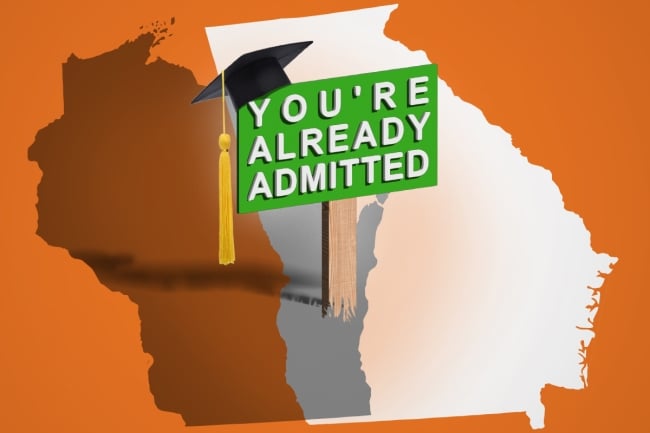You have /5 articles left.
Sign up for a free account or log in.

Georgia and Wisconsin are the latest additions to a growing list of states implementing direct admissions plans across their public four-year institutions.
Photo illustration by Justin Morrison/Inside Higher Ed | Getty Images
The newly rebranded Universities of Wisconsin announced the launch of a direct admissions initiative last week at 10 of the system’s 13 universities. High school students in the state who meet the minimum academic requirements will receive automatic letters of acceptance starting next July.
The UW system’s Board of Regents began discussing the possibility of a direct admissions program over a year ago. Julie Amon, associate vice president for enrollment and student success at the Universities of Wisconsin, said that after gathering evidence from other state adoptees like Minnesota, system leaders were convinced.
The system’s flagship in Madison did not opt in to the program, nor did its campuses in Eau Claire and La Crosse.
Wisconsin is just the latest entrant in a wave of state higher education systems to take up the experimental practice. The University System of Georgia launched its own direct admissions program on Oct. 7, and Indiana’s Commission for Higher Education announced an initiative in August. All told, there are now 10 states with system-level direct admissions; some say that number is likely to multiply in the coming year.
“This fall, [direct admissions] has been the clear trend in state higher ed policy,” said Tom Harnisch, vice president for government relations at the State Higher Education Executive Officers Association. “I think it’s really going to take off.”
Direct admission forgoes the application process altogether—unlike guaranteed admissions plans, such as the top 10 percent plans in Texas and Tennessee, in which students must apply to claim their spot. In direct admissions, students or counselors compile a portfolio of academic information—including areas of interest, geographical preferences and of course grades and test scores—which colleges then use to decide whether to extend an admissions offer.
Advocates of the policy say bypassing the application removes a key barrier for many students who might otherwise not consider college, and it can be a simple and affordable piece of a multifaceted approach to combating enrollment declines. They also say it merely streamlines admissions decisions that, for many of the broad-access institutions adopting the policy, would almost certainly be made anyway.
“A regional comprehensive university is basically already accepting everyone with a GPA of a certain level anyway, so why make them apply?” said Mary Churchill, an associate dean at Boston University’s Wheelock College of Education (and a blogger for Inside Higher Ed). “It’s a no-brainer.”
The Future of (Open-Access) Admissions
Taylor Odle, an assistant professor of educational studies at UW Madison, has been researching the impact of direct admissions for nearly three years. He said that when he first began writing about its effects on colleges in Idaho and South Dakota, many state officials and higher education leaders were deeply skeptical—including some whose states have since adopted the policy.
But it’s grown easier to make the case in the past year or so as the admissions landscape has evolved, he said. The Biden administration’s guidance for colleges dealing with the end of affirmative action, released in August, contained a whole page on direct admissions’ potential as a race-neutral way to increase diversity. Amon said that while the UW system is hoping to open the doors wider for all Wisconsin students, direct admissions could be “life-altering” for first-generation and underrepresented students in particular. It’s also popular for reducing wasteful application systems and buffing up state workforce capabilities. (This paragraph has been updated to add Amon's view of the value of direct admissions for certain populations.)
“Direct admissions is very popular across a diverse array of states because they can market it kind of however they want—addressing enrollment declines, increasing diversity, workforce readiness or just making the process more efficient,” Odle said. “It’s a big umbrella.”
Sonny Perdue, chancellor of the University System of Georgia and a former Republican governor of the state, said the decision to implement a direct admissions program was directly related to the state’s workforce concerns.
“A trained higher educated workforce is what attracts employers to Georgia and supports our economy … it’s a virtuous cycle,” he told Inside Higher Ed. “We wanted to reach those students who are not going to college at all, and it seemed [direct admissions] was the best tool we had.”
How Effective Is It?
Direct admissions is still in its infancy, and its impact on enrollment remains uncertain. Its initial introduction in Idaho and South Dakota, beginning in 2015, showed small but solid enrollment returns. But 2022 was the first year of widespread experimentation with the practice, including a pilot program with the Common App. So far those programs have produced mixed results: a study of the Common App pilot showed that while the policy reliably boosted applications to participating institutions, it didn’t have much of an impact on yield.
Odle noted, though, that the results in states early to adopt direct admissions have been promising; in Idaho, the program has led to an average yearly increase of about 100 to 200 students per participating campus. In any case, he said, the Common App study, which he led, might be a more accurate indicator of direct admissions’ potential for private institutions than for the state systems that are increasingly buying in.
“Those students who are already in the Common App, they’re applying to colleges anyway, and a lot of the time they’re pretty high-achieving. For them, there’s very little benefit to direct admissions,” he said. “But broadly, we should see enrollment increases even if the yield is low, because so many are being admitted. And that can have a real stabilizing impact for struggling regional publics.”
That’s especially important for the UW system, which has suffered greater enrollment problems than public systems in many states; since 2014, college attendees have dropped by 10 percent—or about 20,000 students. For some of the system’s regional universities, the nosedive has been much steeper: UW Platteville, one of the participants in the new direct admissions programs, saw enrollment at its satellite campus in Richland drop by 87 percent over the past decade; last fall only 75 students were enrolled. (This paragraph has been corrected to show UW Platteville's Richland center, not the main Platteville campus, had a steep enrollment drop.)
But Amon and Perdue both said the core group their systems are looking to reach with direct admissions is the students who never even bother setting up a Common App account. That’s a large pool: nearly 40 percent of Georgia high school graduates don’t pursue any postsecondary education, according to USG spokesperson Kristina Torres. A similar number in Wisconsin don’t go to college.
Regardless, many state systems don’t see direct admissions as strictly, or even primarily, an enrollment-boosting strategy. Perdue went so far as to say that while an enrollment spike would be a nice by-product, he didn’t expect Georgia’s new program to have much impact on yield at all.
“This is absolutely not about enrollment … We started this because we believe higher education is valuable for everyone,” he said. “It’s a tap on the shoulder for students to say, ‘Hey, you can do this.’ Whether we reach 10, 20 or 50 percent of those students, we will have succeeded.”
Churchill said the value in direct admissions for state systems is about more than shoring up enrollment: it’s a marketing tool for the value and accessibility of a college degree, aimed at those least likely to pursue it.
“It’s really an awareness-raising campaign for states that are concerned about high school graduates not going on to a postsecondary education,” she said. “And it’s much cheaper than most marketing campaigns. It basically gives you all the access to prospective applicant data you’d get from purchasing a PSAT list, without actually needing to purchase the lists.”
Odle said the initiative’s affordability is part of what has made it increasingly popular. Idaho’s direct admissions program costs about $30,000 a year to run—a much cheaper option than many recruitment and enrollment strategies.
Not every college stands to benefit from direct admissions; it’s “mostly for open-access institutions right now,” Churchill said. Perdue said he didn’t think it likely that the three USG institutions not participating in the program—Georgia Tech, Georgia College & State University and the University of Georgia—would ever opt in. (This paragraph has been updated to correct the non-participating institutions.)
But Churchill believes that as direct admissions programs continue to evolve, flagships and other “semicompetitive” institutions will start to buy in. They might just have their own, slightly higher thresholds for GPA or test scores, or target high schoolers who did particularly well on certain AP subject tests or in particular honors classes to admit them directly to specific programs.
“I see [direct admissions] getting much more nuanced, and even surgical—tailored to individual colleges and programs,” she said. “The flagships could just be waiting to see the early results. Many of those institutions are much broader access than they’d like to admit anyway, with acceptance rates in the high 80s. Some of them need to take a more realistic look at what kind of institution they are and who they serve.”
‘The Next Frontier’
Odle pointed out that filling out the application isn’t the only barrier for students considering college; affordability is an even more important piece of the puzzle. If direct admissions could also be used to reassure families of a degree’s relative affordability or proactively award scholarships, he imagines that would make a huge difference in attainment levels.
“The next frontier is proactive scholarship and financial aid information,” he said.
Amon said that while she couldn’t speak to specifics, the Universities of Wisconsin were “considering many affordability initiatives” to pair with their direct admissions program.
“I think that’s an issue that all universities engaging in direct admissions are going to have to grapple with next,” she said. “It’s one thing for a student to understand, ‘Yes, I’m wanted here.’ The next question they ask is ‘Is it going to be possible for me?’”
Regardless of further innovations, Odle said interest in direct admissions will only continue to surge; he predicted a “massive wave” of state adoptions in the next year or two. Churchill said that even if state systems don’t buy in to the trend, regional public universities strapped for students and cash might implement their own individually—like leaders at UW Green Bay did in February, months before the rest of their system caught up.
“Poaching across state lines is growing, and competition between states for students is getting more intense every year,” she said. “State systems are just going to get more creative and more entrepreneurial, and I think direct admissions is going to be an essential piece of that.”





